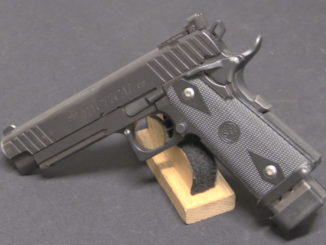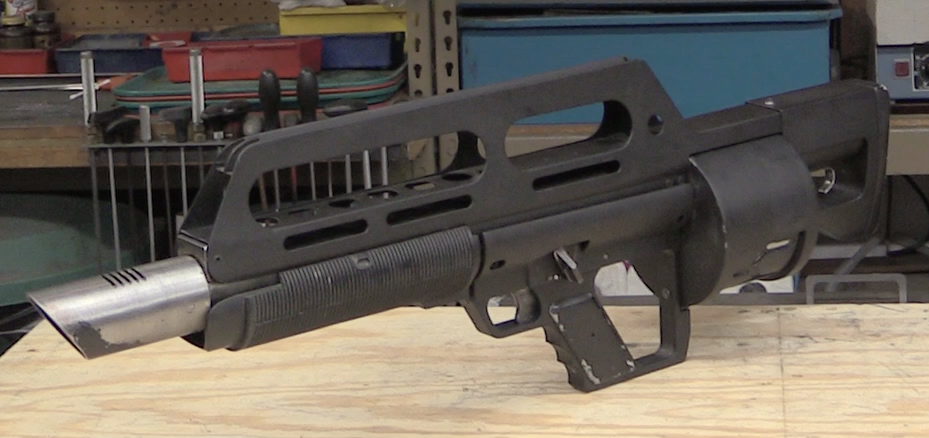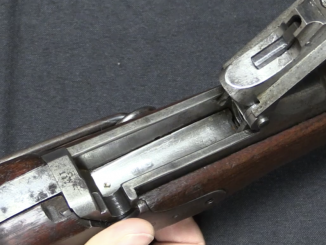Today’s firearm is not a normal gun; it is a conversion of a Spencer into a shotgun. My question is, what path did this weapon travel? What did it begin as, and how did it come to be in its current form?
Let’s see if we can puzzle this out looking at the evidence in the gun itself…




My first guess was that the rifle sights were the result of a “Hollywood” conversion. That is, the weapon was altered to look like a Spencer rifle for use in a movie. For that, I would also expect that the breechblock would be altered from rimfire to centerfire to use theatrical blanks, probably cut-down from .45-70 blanks.
However, IMFDB has a listing for Spencer carbines used in films, but no mention of any full-length rifles used;
http://www.imfdb.org/wiki/Spencer_1860_Carbine
Note that all the films listed were made within the last three decades. Which would put a relatively recent “time span” on such a conversion.
So, I’ll have to side with Ian and say it may have been modified for use by re-enactors. Or just as a wall-hanger.
BTW, the nockform on the receiver top doesn’t look “worn off” to me. More like “ground off”. Fairly recently, too.
cheers
eon
Yeah, the top of the receiver has probably been filed to remove the markings put there by the folks who converted it to a shotgun. Then they cobbled the rest together to make it look like a Spencer rifle. My guess is that this “restoration” was done somewhere near a gun show, and the purpose was to dupe somebody out of their money. ^__^
Somewhere near the Khyber pass: “Dad, look, that crazy thing you made last year made the internet”
Giggling over the Kyber pass comment!!!!
Off topic a bit, but i wonder why so few Explora / Paradox rifled shotgun conversions were made in the post civil war era.
Also I wonder if it could or was done reverse of the classic rifled of the last 4-6 inches of the barrel but the first 4 to 6 inch with what would be a long false muzzle ?
Could it be that the person who converted it to a shotgun wanted to give the appearance of a rifle?
A shotgun would be the handier tool for traveling, however if you are in “rough country” the rifle demands a little more respect. It seems that who ever did the conversion had skill and a plan.
Or maybe it was made to give to a wife when the husband was away. A 20 g shotgun can be handled by most small stature d people and I bet that shotgun/rifle would be a soft shooter.
I love a mystery! And Thank you Ian for a delightful website, I’ve been devouring all you info and am now a daily visitor.
There are .50 cal shotshells for the Remington Rolling pistols.
I thought that it is interesting that it has a shotgun barrel but a 56 Spencer chamber. I wonder how they joined the two?
Hello, Ian:
In Gun Report magazine, March 1980, page 60, there is a photo of a Spencer converted to a shotgun. Like yours, the markings are ground off of the knox form, there is a bead sight, the low serial number is 1812, the sling bar is the same as yours. Unlike yours, this is a half-stock gun with no barrel bands and no rear sight. I would guess yours was “upgraded” from one of these converted carbines.
The author of the article speculates that these guns were made up of parts by Winchester after they purchased the Spencer Company and its assets. He speculates they removed Spencer’s name. He mentions UMC made Spencer Shot shells with a wooden “bullet” so that they would feed. He is obviously guessing that Winchester made these guns. Actually, Winchester did not complete the purchase of Spencer, so his theory fails.
I would be more inclined to think they were made by some firm such as Schuyler, Hartley & Graham, or perhaps, Hibbard Spencer Bartlett & Co.
Was the barrel made by welding an extension on as was common to do?
Was it converted to center fire like the the Bristol shotgun conversions were?
I don’t think it was a Bristol as I don’t think that Bristols kept the barrel ring on.
More likely it’s a barrel sourced from another longarm. For example, an early-production Spencer 1860 infantry rifle barrel that had its bore “shot out”, that was bored out to 20 gauge (~.59 cal.) spec except for the chamber and (probably) the leade’.
But if this were so I’d have expected the rile sights to be in their proper places and the rear sight to be in its proper depth in its recess. Since the rear sight dovetail is shallower, I’d say that Ian is correct in concluding that it was cut later specifically to avoid cutting into the larger bore.
So, what other weapon could have contributed the barrel?
The first “suspect” is an unfinished, original Spencer rifle barrel. This would have to have been obtained from the factory, most likely. In fact, there’s an excellent chance that the original shotgun conversion was done at the factory on a customer’s carbine sent in for the purpose.
Keep in mind that Spencer went bankrupt in 1866-67, and the assets including parts and machinery were bought by the new Winchester company. Who would do “custom work” for anybody who was willing to pay.
The second possibility is also Winchester. That is, that it was made up at the plant by them from existing parts either as an experiment, or just because somebody there wanted a Spencer repeating shotgun. Factory “prototype” or “workman’s toy”, such things were far from unknown back then.
The third possibility is a frontier gunsmith conversion. The .59 cal. barrel could be a musket or rifle barrel (the latter probably a .54 bored out), with the chamber end sleeved, bored to Spencer chamber spec, and then threaded on the outside to mate with the Spencer receiver. This would be very difficult to detect without dismantling the weapon, although if it has been chamber sleeved there should be a very thin but discernible “mating ring” forward of the chamber in the bore surface itself. (Borescope time.)
When I was younger (three decades ago), this method was used quite often to rechamber oddball 9mms like the 9 x 21 Steyr to 9 x 19mm. Bore out the chamber area to 0.5″ diameter and a depth of 1.00″, insert a tool-steel liner of 8mm ID, brazed or hard-soldered in place, then run a tungsten-carbide 9 x 19mm chambering reamer into it. (Use plenty of cutting oil, BTW.) It was also the best way to re-establish correct and safe headspace in a barrel with a worn chamber, short of boring it out completely and sleeving it from stem to stern.
See Pistolsmithing by George Nonte for the details on these procedures;
http://www.amazon.com/Pistolsmithing-Stackpole-Classic-Gun-Books/dp/0811708217
(I’m glad to see it back in print. Nobody’s getting my original edition copy.)
Anyway, a frontier conversion would explain the bead front sight. That being the typical shotgun sight then and later.
For that matter, a lot of early .54 cal. muzzle-loading rifles had a small blade front sight and a fixed or two-position rear. One of those might have been the “donor”, with the bead front sigh replacing the small blade and not bothering with a rear sight.
In fact, the “factory” Spencer rifle sights that are on it now are sitting just about where I’d expect the front and rear sights on a .54 muzzle-loading rifle to be on the barrel. Also, in installing them, whoever “revamped” this one probably neatly eliminated the most obvious evidence of the barrel’s actual “nativity”.
Just a guess, take it for what it’s worth.
cheers
eon
“9 x 21 Steyr to 9 x 19mm”
You probably mean 9×23 Steyr (9×21 is Russian cartridge for Veresk sub-machine gun). BTW: If IIRC unmodified Steyr Hahn can fire 9×19 if it is chambered manually.
Many surplus rifles get shotgun conversions, after war, for various reasons. I would bet almost any rifle used in bigger quantity has its shotgun conversion.
is: “any rifle”
should be: “any military repeating rifle”
At different times, the Steyr round has been referred to as a 9 x 21, 9 x 23, 9 x 22.5, and at least one source calls it a 9 x 24.
The factory originally called it the 9 x 21 M1912 to distinguish it from the 9 x 19 Parabellum, 9 x 23 Bergmann-Bayard “Long”, and 9 x 25 Mauser.
In fact, chamber and cartridge case length specs on the 9mm Steyr seem to have been “loose” enough that you could call it any or all of the above and be correct for at least some lots of guns and/or ammunition from the manufacturer. I doubt anyone really knows for sure.
cheers
eon
Ok, I google for photos of 9mm cartridges box and most often label is 9mm Steyr (or 9m/m Steyr or similar), according to municion:
http://www.municion.org/Steyr/9Steyr.htm
Case length is 23,05mm so I refer to it as 9x23mm Steyr
CIP data says 23.20mm -0.25mm, so 9×23 Steyr would seem to be the most accurate name, if one insists on including the case length. The official name is just “9 mm Steyr”, which does not leave much room for misunderstandings.
http://www.cip-bobp.org/homologation/uploads/tdcc/tab-iv/tabivcal-en-page29.pdf
My current shotgun interest is the WW1 Mauser 98s that were converted to shotguns.
One of those guns that I didn’t know about, but once I ran across the 1st on they seem to be at every gun show I go to. Plus fit my budget.
See page 159 in the book “Spencer Repeating Firearms” by Roy M. Marcot for a copy of an add from Bristol Mfg. Co. In the add Bristol states that some competitors of theirs weld the barrels up from 2 pieces.
The author also states that Winchester never made any Spencer shotguns.
FWIW. Bristol sold their’s for $13.
Speaking of odd conversions, is this below a Mauser 1871 bolt action converted with a shotgun barrel?
https://www.flickr.com/photos/costicaacsinte/14329536644/in/photostream/lightbox/
https://www.flickr.com/photos/costicaacsinte/14328506992/in/photostream/lightbox/
Friends,
My Arisaka Type 99 shotgun conversion into a .410 makes this military rifle fun to use.
I use shot shells in revolvers.
Snap shooting is a joy with cartridge arms using shot shells.
Not only do I have fun shooting balls in the air, I actually hit them!
Q
Guys, I know this is an old post, but I have one just like it. It was in my family’s house in Brooklyn, NY back to the late 1800’s – early 1900’s. It hangs over my kitchen fireplace today. It is exactly the same. Serial number on the tang is 14380. Serial number on the underside of the stock is 1110 or 110. It weighs a ton…